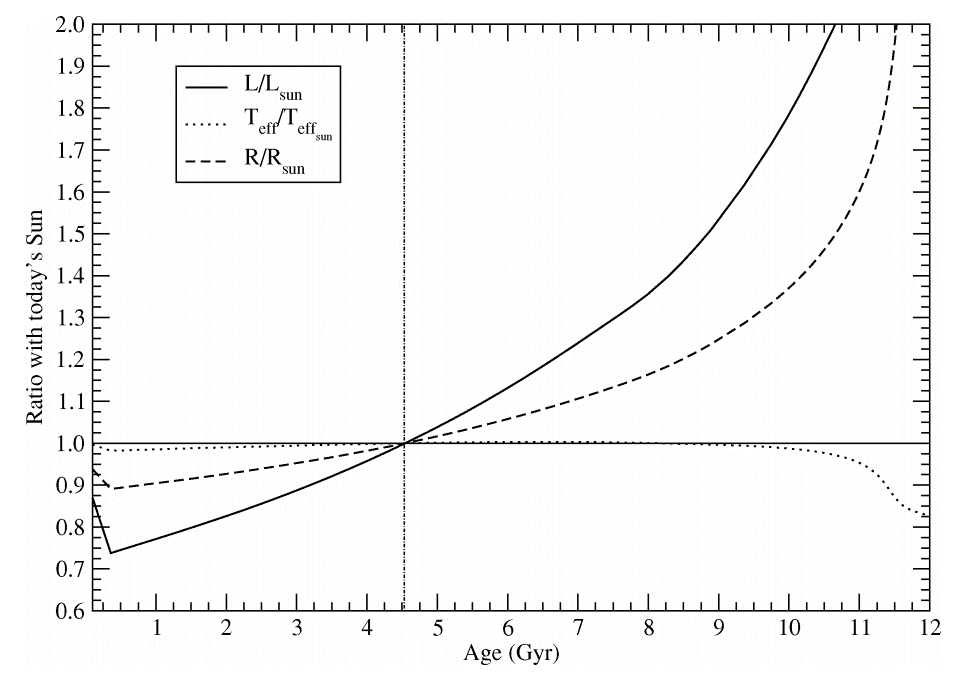Variation of luminosity and radius during main-sequence phase#
Raise of the question#
When considering the evolution of habitable zone in solar system, wikipedia says:
Even while stars are on the main sequence, though, their energy output steadily increases, pushing their habitable zones farther out; our Sun, for example, was 75% as bright in the Archaean as it is now (Kasting & Ackerman 1986), and in the future, continued increases in energy output will put Earth outside the Sun’s habitable zone, even before it reaches the red giant phase (Franck+2002).
This can be visualized by the output of stellar evolution code:
 Figure 1 of Ribas 2009. Based on the Yonsei-Yale evolutionary sequences.
Figure 1 of Ribas 2009. Based on the Yonsei-Yale evolutionary sequences.
The change of these values follow the difination of luminosity:
$$ L = 4 \pi r^2 \sigma T_\mathrm{eff}^4 $$
The change of effective temperature should be derived from the change in L and r.
Here we explain the reason of this change. The derivation follows the contents in Stellar Structure and Evolution (Kippenhahn+2012), so the numbering of euqations corresponding to the numbering in the book.
We have the basic differential equations for a spherically symmetric star in hydrostatic equilibrium:
$$ \frac{\parial r}{\parial m} = \frac{1}{4\pi r^2 \rho} \tag{10.1}$$
$$ \frac{\parial P}{\parial m} = -\frac{Gm}{4\pi r^4} \tag{10.2}$$
$$ \frac{\parial l}{\parial m} = \epsilon \tag{10.3}$$
$$ \frac{\parial T}{\parial m} = -\frac{GmT}{4\pi r^4 P} \nabla = -frac{3}{64\pi^2 ac} \frac{\kappa l}{r^4 T^3} \tag{10.4, 10.6}$$
The last equation assume the energy transport is due to radiation (which is the case for sun).
Since the hydrogen fusion only lost 0.7% of the mass, we assume the structure of the sun during main-sequence is not changed, only the molecular weight is varied. Thus we are discussing homologour stars, with their mass \(m\) and radius \(r\) in a particular point following the equation \(m/M=m'/M', r/R=r'/R'\), with \(M\) representing the total mass of a star and \(R\) representing the radius.
Define relative mass value \(\ksi\) as:
$$ \ksi \coloneqq m/M=m’/M’, \tag{20.1}$$
then the homology condiction is:
$$ \frac{r(\ksi)}{r’(\ksi)} = \frac{R}{R’} \tag{20.2} $$
For convenience, define several ratios:
$$ x = M / M’; y = \nu / \nu’ \tag{20.3}$$
$$ x = r / r’ = R / R’; p = P / P’ = P_\mathrm{c} / P’\mathrm{c}; t= T / T’ = T\mathrm{c} / T’_\mathrm{c}; s = l / l’ = L / L’ \tag{20.4}$$
$$ d = \rho / \rho’; d = \epsilon / \epsilon’; k = \kappa / \kappa’ \tag{20.7}$$
In general \(\epsilon\) depends on temperature and density and on the abundance of the different nuclear species that react, described in detail in Chap. 18. – SSE p32.